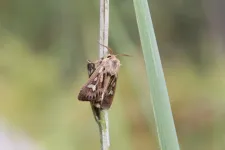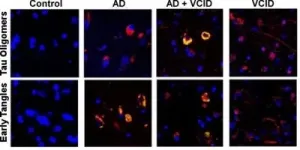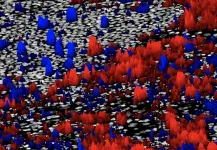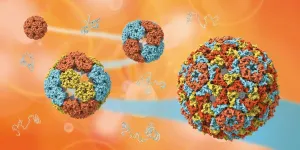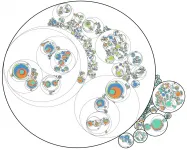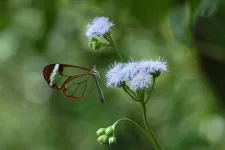Novel liquid crystal metalens offers electric zoom
2021-06-10
(Press-News.org) ITHACA, N.Y. - Researchers from Cornell University's School of Applied and Engineering Physics and Samsung's Advanced Institute of Technology have created a first-of-its-kind metalens - a metamaterial lens - that can be focused using voltage instead of mechanically moving its components.
The proof of concept opens the door to a range of compact varifocal lenses for possible use in many imaging applications such as satellites, telescopes and microscopes, which traditionally focus light using curved lenses that adjust using mechanical parts. In some applications, moving traditional glass or plastic lenses to vary the focal distance is simply not practical due to space, weight or size considerations.
Metalenses are flat arrays of nano-antennas or resonators, less than a micron thick, that act as focusing devices. But until now, once a metalens was fabricated, its focal length was hard to change, according to Melissa Bosch, doctoral student and first author of a paper detailing the research in the American Chemical Society's journal Nano Letters.
The innovation, developed in the collaboration between Samsung and Cornell researchers, involved merging a metalens with the well-established technology of liquid crystals to tailor the local phase response of the metalens. This allowed the researchers to vary the focus of the metalens in a controlled way by varying the voltage applied across the device.
"This combination worked out as we hoped and predicted it would," said Bosch, who works in the lab of Gennady Shvets, professor of applied and engineering physics and senior author of the paper. "It resulted in an ultrathin, electrically tunable lens capable of continuous zoom and up to 20% total focal length shift."
Samsung researchers are hoping to develop the technology for use in augmented reality glasses, according to Bosch. She sees many other possible applications such as replacing the optical lenses on satellites, spacecraft, drones, night-vision goggles, endoscopes and other applications where saving space and weight are priorities.
Maxim Shcherbakov, postdoctoral associate in the Shvets lab and corresponding author of the paper, said that researchers have made progress in marrying liquid crystals to nanostructures for the past decade, but nobody had applied this idea to lenses. Now the group plans to continue the project and improve the prototype's capabilities.
"For instance," Shcherbakov said, "this lens works at a single wavelength, red, but it will be much more useful when it can work across the color spectrum - red, green, blue."
The Cornell research group is now developing a multiwavelength varifocal version of the metalens using the existing platform as a starting point.
"The optimization procedure for other wavelengths is very similar to that of red. In some ways, the hardest step is already finished, so now it is simply a matter of building on the work already done," Bosch said.
INFORMATION:
This work was supported by the Global Research Outreach program of the Samsung Advanced Institute of Technology and, in part, by the Cornell Center for Materials Research with funding from the National Science Foundation and the U.S. Office of Naval Research.
ELSE PRESS RELEASES FROM THIS DATE:
2021-06-10
Climate change exerts great pressure for change on species and biodiversity. A recent study conducted by the University of Helsinki and the Finnish Environment Institute indicates that the few moth and butterfly species (Lepidoptera) capable of adjusting to a changing climate by advancing their flight period and moving further north have fared the best in Finland. In contrast, roughly 40% of Lepidoptera species have not been able to respond in either way, seeing their populations decline.
Climate change is bringing about rapid change in Finnish nature - can species keep up with the pace? Adjusting to climate change can manifest through earlier phenology such as moth and butterfly flight periods, bird nesting, or ...
2021-06-10
Researchers remain perplexed as to what causes dementia and how to treat and reverse the cognitive decline seen in patients. In a first-of-its-kind study, researchers at the Medical University of South Carolina (MUSC) and Beth Israel Deaconess Medical Center (BIDMC), Harvard Medical School discovered that cis P-tau, a toxic, non-degradable version of a healthy brain protein, is an early marker of vascular dementia (VaD) and Alzheimer's disease (AD). Their results, published on June 2 in Science Translational Medicine, define the molecular mechanism that causes an accumulation of this toxic protein. Furthermore, they showed that ...
2021-06-10
WACO, Texas (June 9, 2021) - Most people listen to music throughout their day and often near bedtime to wind down. But can that actually cause your sleep to suffer? When sleep researcher Michael Scullin, Ph.D., associate professor of psychology and neuroscience at Baylor University, realized he was waking in the middle of the night with a song stuck in his head, he saw an opportunity to study how music -- and particularly stuck songs -- might affect sleep patterns.
Scullin's recent study, published in Psychological Science, investigated the relationship between music listening and sleep, focusing on a rarely-explored mechanism: involuntary musical imagery, or "earworms," when a song or tune replays ...
2021-06-10
June 10, 2021, CLEVELAND: A new Cleveland Clinic-led study has identified mechanisms by which COVID-19 can lead to Alzheimer's disease-like dementia. The findings, published in Alzheimer's Research & Therapy, indicate an overlap between COVID-19 and brain changes common in Alzheimer's, and may help inform risk management and therapeutic strategies for COVID-19-associated cognitive impairment.
Reports of neurological complications in COVID-19 patients and "long-hauler" patients whose symptoms persist after the infection clears are becoming more common, suggesting that SARS-CoV-2 (the virus that causes COVID-19) may have lasting effects on brain function. However, it is not yet well understood how the virus leads to neurological issues.
"While some studies suggest ...
2021-06-10
The human heart contracts about 70 times per minute, while that of a rat contracts over 300 times; what accounts for this difference? In a new study publishing 10th June in the open-access journal PLOS Biology, led by Michael Geeves and Mark Wass of the University of Kent and Leslie Leinwand from the University of Colorado Boulder, reveal the molecular differences in the heart muscle protein beta myosin that underly the large difference in contraction velocity between the two species.
Myosin is a "molecular motor" - an intricate nanomachine that forms the dynamic core of a muscle's contractile machinery, burning ...
2021-06-10
Pairing sky-mapping algorithms with advanced immunofluorescence imaging of cancer biopsies, researchers at The Mark Foundation Center for Advanced Genomics and Imaging at Johns Hopkins University and the Bloomberg~Kimmel Institute for Cancer Immunotherapy developed a robust platform to guide immunotherapy by predicting which cancers will respond to specific therapies targeting the immune system.
A new platform, called AstroPath, melds astronomic image analysis and mapping with pathology specimens to analyze microscopic images of tumors.
Immunofluorescent imaging, using antibodies with fluorescent tags, enables researchers to visualize multiple cellular proteins simultaneously and determine their pattern and strength of expression. Applying AstroPath, ...
2021-06-10
The team say their findings have implications for the treatment of viruses in future.
Researchers from the Universities of York and Leeds, collaborating with the Hilvert Laboratory at the ETH Zürich, studied the structure, assembly and evolution of a 'container' composed of a bacterial enzyme.
The study - published in the journal Science - details the structural transformation of these virus-like particles into larger protein 'containers'.
It also reveals that packaging of the genetic cargo in these containers becomes more efficient during the later stages of evolution. They show that this is because the genome inside evolves hallmarks of a mechanism widely ...
2021-06-10
The specific traits of a plant's roots determine the climatic conditions under which a particular plant prevails. A new study led by the University of Wyoming sheds light on this relationship -- and challenges the nature of ecological trade-offs.
Daniel Laughlin, an associate professor in the UW Department of Botany and director of the Global Vegetation Project, led the study, which included researchers from the German Centre for Integrative Biodiversity Research in Leipzig, Germany; Leipzig University; and Wageningen University & Research in Wageningen, Netherlands.
"We found that root traits can explain species distributions across the planet, which has never been attempted ...
2021-06-10
It's often cancer's spread, not the original tumor, that poses the disease's most deadly risk.
"And yet metastasis is one of the most poorly understood aspects of cancer biology," says Kamen Simeonov, an M.D.-Ph.D. student at the University of Pennsylvania Perelman School of Medicine.
In a new study, a team led by Simeonov and School of Veterinary Medicine professor Christopher Lengner has made strides toward deepening that understanding by tracking the development of metastatic cells. Their work used a mouse model of pancreatic cancer and cutting-edge techniques to trace the lineage and gene expression patterns of individual cancer cells. They found a spectrum of aggression in the cells that arose, with cells ...
2021-06-10
WOODS HOLE, Mass. -- Many animals have evolved camouflage tactics for self-defense, but some butterflies and moths have taken it even further: They've developed transparent wings, making them almost invisible to predators.
A team led by Marine Biological Laboratory (MBL) scientists studied the development of one such species, the glasswing butterfly, Greta oto, to see through the secrets of this natural stealth technology. Their work was published in the Journal of Experimental Biology.
Although transparent structures in animals are well established, they appear far more often in ...
LAST 30 PRESS RELEASES:
[Press-News.org] Novel liquid crystal metalens offers electric zoom
